Add description, images, menus and links to your mega menu
A column with no settings can be used as a spacer
Link to your collections, sales and even external links
Add up to five columns
Add description, images, menus and links to your mega menu
A column with no settings can be used as a spacer
Link to your collections, sales and even external links
Add up to five columns

American Flag - Understanding the Parts of the US Flag
9 min read
Specific terms are used to describe parts of the US flag.
Some terms refer to the physical pieces used to assemble the flag, and some terms refer to the elements of the flag, identifying their position and location regarding flag design.
And not every flag is created equally. The flag of the USA can be configured differently for unique applications.
Basic Parts of the American Flag
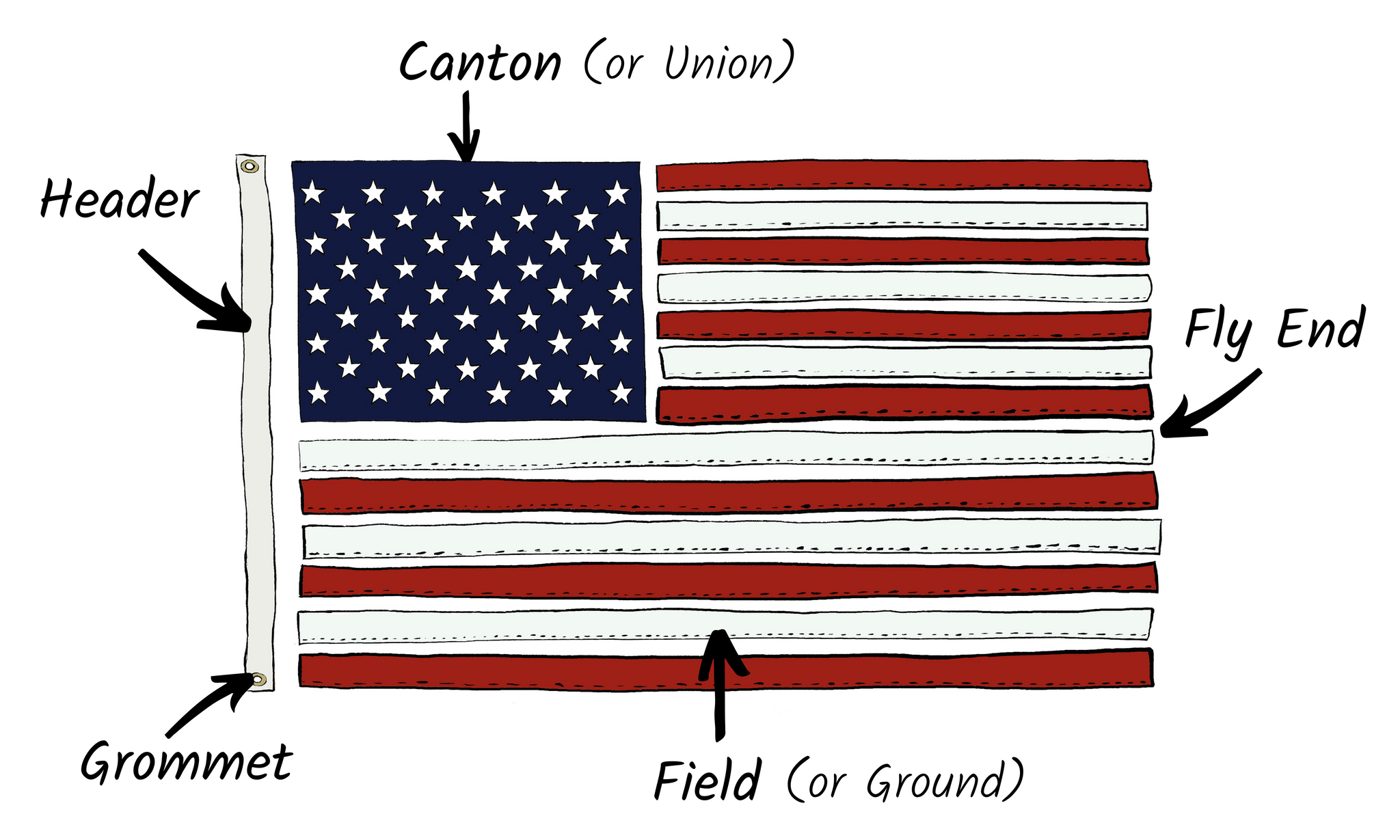
Glossary
Header (or heading) - The header is a band of material placed on the pole side (hoist) of the flag, it serves to secure the flag to the halyard line. The header is usually made of a thick cotton/poly blend that feels like canvas.
Grommet - A metal ring or eyelet embedded in the header. These are usually made of brass and used to secure an outdoor flag.
Canton - Technically the canton can be any quarter of the flag. In modern flag design it usually refers to the top left corner (upper hoist), which is the position of honor. The canton of the US flag is also called the Union - the blue background where the 50 stars are sewn or appliqued.
Field - the background or predominant color of the flag.
Fly End - The fly end is the edge of the flag furthest away from the pole. The term fly is used to describe the length of the flag, and the fly end is the side that is not secured. By nature, it "flies" freely and endures the most stress or whip.
Position Terms Used to Describe the American Flag
Glossary
Hoist - The term hoist is used to refer to the half (and edge) closest to where the flag is hung. It also refers to the distance from top to bottom of the flag. This is confusing since it is a vertical measurement, but describes the flag's width.
Upper Hoist - Imagine the flag is broken into four quadrants and each quadrant is named for the edges it borders, the upper hoist is the upper left corner.
Lower Hoist - lower left quadrant of the flag, nearest to the flag pole
Fly - The term fly is used to describe the half and edge of the flag that is furthest away from the pole. It can also be used to describe the length (horizontal measurement) of the flag.
Upper Fly - the top quarter of the flag furthest away from the pole
Lower Fly - bottom right quadrant of the flag
Fly End - The fly end is the edge of the flag that is furthest away from the pole - the end that "flies" freely.
Position of Honor - The position of honor is generally the upper hoist. This is also commonly referred to as the canton. Many colony flags use this area to honor their ruling country. Australia is now independent but the flag of Australia 🇦🇺is a good example.
Banner Style American Flag
US Flags with a pole hem are sometimes called banners. Instead of grommets and a header they are designed so that a sleeve slides over the pole.
These are often used with indoor pole sets, porch flags and parade display.

Glossary
Pole Hem - The term pole hem refers to a sheath on the hoist side used to fit over a pole. In order to create the sleeve, either the main flag material is extended or additional material is added.
When the flag material is extended the colors of the stripes and canton continue and the flag appears to be elongated. If extra material is added it is usually white and looks like a traditional header.
Sleeve - The sleeve is the opening (sheath) on the pole side of the flag that slides over a pole.
Tab - A button-hole will be sewn into the sleeve. It is usually leather and can be found at the top, just inside the sleeve. This tab is used to secure the flag to the pole.
Banner - An American flag with a pole sleeve is often referred to as a banner. The term "banner" is used broadly and includes flags in general, so often the terms are interchangeable. But, historically, a banner is stretched between two points and often has text.
Rope and Thimble Heading
Large flags require more support in the header. The extra weight could cause the header to tear off the flag, so the solution is a rope and thimble. This type of attachment also allows a bigger flag to fly better.
 Glossary
Glossary
Thimble - The thimble is a horse-shoe shaped steel piece with a channel. This is designed to hold a rope. The thimbles are usually made of galvanized steel for strength, durability, and to avoid rust.
Rope - Nylon rope that runs through the header and around each thimble.
Size - Rope and thimble riggings are usually reserved for flags that are 8' x 12' and above. Smaller flags don't require as much support and can be flown with a traditional header and grommets set up.
American Flag Design - What do the Stars, Stripes, and Colors Symbolize?
While we are examining the parts of the US flag - here is a brief explanation of what each part of the flag means.
The flag of the USA has a few nicknames. Sometimes referred to as Old Glory, The Stars and Stripes or The Star Spangled Banner. Over the years there have been many variations. As states have been added to the Union, the flag has evolved. Learn the history of the American Flag.
The original Flag Act of 1777 made no provision for the position of the stars and stripes, which meant it was left up to the imagination of the flag maker.
This freedom produced flags in all shapes, sizes, and combinations. Here is an example from 1845.
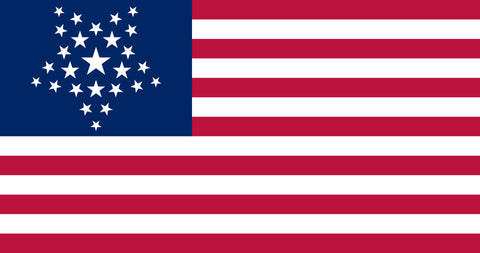
This was finally changed in 1912 when President William Howard Taft signed an executive order declaring an official flag design. The current version (50 stars) became official on July 4,1960 and is the longest running American flag design.
So let's take a look.
American Flag Colors
Specifically, the colors are "White", "Old Glory Red", and "Old Glory Blue". Based on color a card published by the JOSA, the colors are specified in terms of fabric.
In order to use official flag colors for screen or print the State Department recommends the following translation.
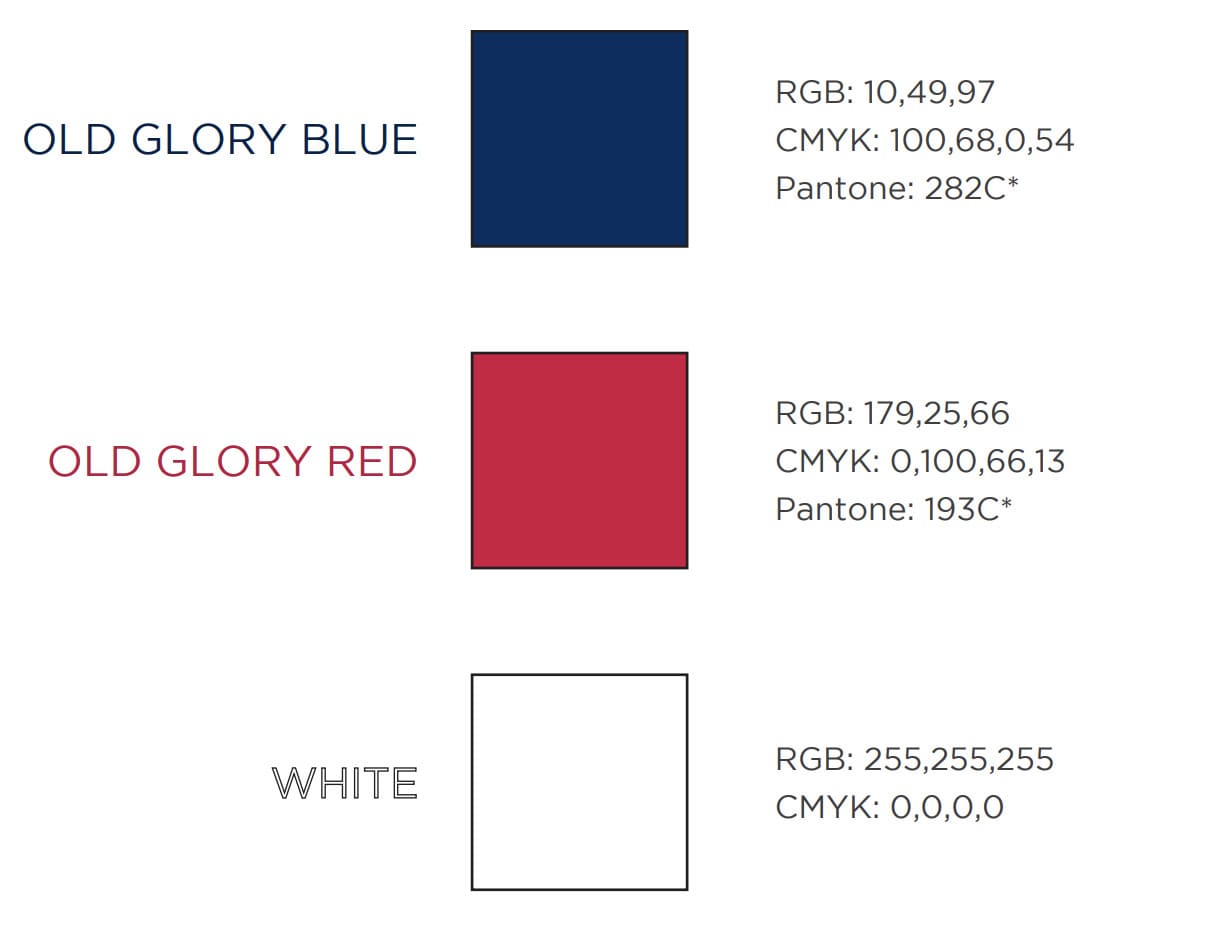
Contrary to popular myth, the colors of the flag were not chosen for any specific meaning. They were simply inherited from the flag of Great Britain. (King's Colours)
Later, when the seal of the United States was designed, the colors (red, white, and blue) were reused for consistency and specific meanings were assigned.
Reporting to Congress, Charles Thompson (Secretary), described the new Seal as follows:
"The colors of the pales (the vertical stripes) are those used in the flag of the United States of America; White signifies purity and innocence, Red, hardiness & valour, and Blue, the color of the Chief (the broad band above the stripes) signifies vigilance, perseverance & justice."

For this reason, it is common to attribute the same meanings from the Seal to the colors of the American flag.
In 1986, president Ronald Reagan interpreted the colors this way:
"The colors of our flag signify the qualities of the human spirit we Americans cherish. Red for courage and readiness to sacrifice; white for pure intentions and high ideals; and blue for vigilance and justice."
American Flag - Official Dimensions and Ratios Explained
Official US flag dimensions are spelled out in the US Code. Title 4, Chapter 1, is called The Flag, and is commonly referred to as the US Flag Code.
One important note. The "official" dimensions apply to the executive branch of Government and are required for flags that are displayed in specific government areas. Flags that adhere to these dimensions are considered G-Spec or Government Specified.
For the general public, it is more common and popular to fly the American flag in sizes of 12x18", 2'x3', 2.5"x4', 3'x5', 4'x6', and 5'x8'.
If you take a closer look, you will notice when the flag is in G-Spec ratio:



US Flag Design - What Do the Stars and Stripes Represent?
We have already dissected the flag into parts, now it's time to explain the meaning behind each symbol.
From the US Flag Code: Section1
The flag of the United States shall have thirteen horizontal stripes, alternate red and white, and a union consisting of white stars on a field of blue
Thirteen Stripes
The 13 Stripes on the American flag represent the 13 original colonies/states of Connecticut, Delaware, Georgia, Maryland, Massachusetts, New Hampshire, New Jersey, New York, North Carolina, Pennsylvania, Rhode Island, South Carolina, and Virginia.
There are 7 red stripes alternating with 6 white stripes - red on top and bottom. The stripes are of equal width and run horizontally.
Francis Hopkinson is given credit for the first United States flag design.
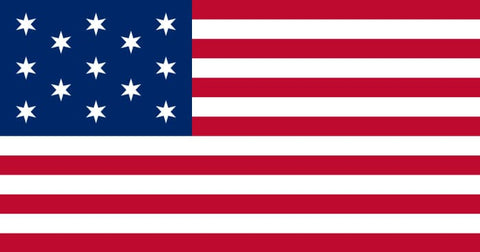
Hopkinson actually designed two flags, one for the Navy and one for the U.S. government. The only difference between the two flags was the order of the stripes. The naval flag started with a red stripe and the government started with a white stripe on top.
Some speculate that red eventually took its place on top and bottom for practical reasons, white would show more wear and tear.
Fifty Stars
The 50 white stars of the flag represent each of the 50 states in the United States.
Originally, the stars were to signify a "new constellation". As the number of stars changed with the addition of new states, so did the arrangement of stars on the flag.
The current arrangement is 9 rows. The rows are slightly offset, alternating 6 stars in a row on top and bottom with 5 star rows between. Each star should be aligned with a single point on top.
In 1958, Robert Heft was a high school student. The stars of Hawaii and Alaska were being added to the flag and new design submissions were being accepted.
Heft submitted his design as a class assignment. His teacher, Stanley Pratt, gave him a B- for the design, saying "it lacked imagination".
The two made a deal that if the design was accepted by Congress, Taft would change the grade to an A. Heft's design was chosen by Congress and President Dwight D. Eisenhower from over 1500 submissions, and the rest is history.
When the time comes, Heft has a design for an American Flag with 51 stars.

Significance of the Five-Pointed Star

Before it was introduced in the design of the United States Flag, the five-pointed star was rarely used in Heraldry.
Heraldry is the study, design, and display of armorial bearings. Flags often take their design from military influence and heraldic devices. In the 18th Century, it was much more common to use a six-pointed star.
Francis Hopkins' original designs did include six-pointed stars. And since the Flag Act of 1777 was so vague, flag makers were free to interpret the Stars and Stripes design and arrangement.
Which leads us to the myth and legend of Betsy Ross.
In 1776, Colonel George Washington, George Ross (Betsy's great uncle), and Robert Morris, approached an upholsterer named Betsy Ross to commission a flag.
The delegation presented a design with 6-pointed stars. (Supposedly, they preferred 5-pointed stars, but thought it would be difficult to mass produce.)
According to legend, Betsy Ross presented an easy way to make a five-pointed star with just one scissor cut and the new design was born.
Ross is also attributed with placing the13 stars in a circle.
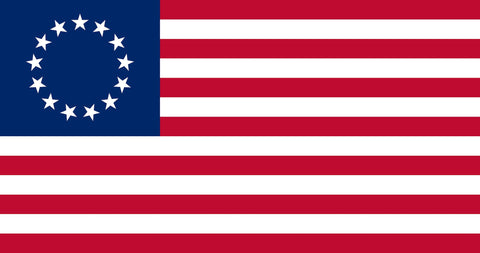
This is where fact and myth get murky. No evidence comes directly from anyone involved and there was no documentation of those events until nearly 100 years later.
Also, the oldest representation of the "Betsy Ross" flag is from 1792, in a painting by John Trumbull.
While the complete design is in question, it is likely that Betsy Ross deserves credit for the the 5-pointed star modification. Five-pointed stars are now more commonly used in flags and in Western culture have become synonymous with fame or "stardom".
FAQs
Which end is the fly end of the flag?
The fly end is the edge of the flag furthest away from the pole. The term fly is used to describe the length of the flag, and the fly end is the side that is not secured. By nature, it "flies" freely and endures the most stress or whip.
What part of a flag is the canton?
Technically the canton can be any quarter of the flag. In modern flag design it usually refers to the top left corner (upper hoist), which is the position of honor. The canton of the US flag is also called the Union - the blue background where the 50 stars are sewn or appliqued.
What is a grommet on a flag?
A grommet is a metal ring or eyelet embedded in the header. These are usually made of brass and used to secure an outdoor flag.
Do the 13 stripes on the American flag have meaning?
The 13 Stripes on the American flag represent the 13 original colonies/states of Connecticut, Delaware, Georgia, Maryland, Massachusetts, New Hampshire, New Jersey, New York, North Carolina, Pennsylvania, Rhode Island, South Carolina, and Virginia.
There are 7 red stripes alternating with 6 white stripes - red on top and bottom. The stripes are of equal width and run horizontally.
What do the fifty stars on the US flag represent?
The 50 white stars of the flag represent each of the 50 states in the United States.
Who designed the arrangement for the 50 stars on the US flag?
The current arrangement of 9 rows of stars was designed by a high school student named Robert Heft. He submitted the design for a class project and Congress ultimately adopted the configuration. Heft already has a design in mind for the 51st star.
THE END
Also in Patriot Journal – A Patriotic Blog of Flag Etiquette Articles, USA Pride Stories, American Flag History, and Seasonal Flag Education for Proud Americans

Is There a Proper Way to Fold The American Flag?
12 min read
Folding the American Flag correctly is more than tradition—it’s a sign of respect. In this guide from Fine Line Flag, we walk you through the proper way to fold the U.S. flag, step by step, and explain the meaning behind each of the 13 folds.

How To Choose the Best Flag Material | Indoor and Outdoor
9 min read
Not sure what flag material to choose? Fine Line Flag breaks it down in this expert guide to help you find the best fabric for your needs.

Why is the Chicago Flag So Popular? And What Does It Mean?
8 min read
The Chicago flag isn’t just a city symbol—it’s a badge of identity. In this Fine Line Flag guide, we uncover why the Chicago city flag has become one of the most beloved and recognizable civic flags in America.
Shop the Fine Line Flag Collection!

American Flags Made in the U.S.A. – Premium Outdoor & Indoor U.S. Flags for Sale
American Flags Made in the U.S.A. – Premium Outdoor & Indoor U.S. Flags for Sale
American Flags Made in the U.S.A. – Premium Outdoor & Indoor U.S. Flags for Sale
View All

First Responder Flags – Thin Blue Line & Thin Red Line Flags to Honor Police, Firefighters & EMTs
First Responder Flags – Thin Blue Line & Thin Red Line Flags to Honor Police, Firefighters & EMTs
First Responder Flags – Thin Blue Line & Thin Red Line Flags to Honor Police, Firefighters & EMTs
View All

Patriotic Merchandise – Wall Art, Decals, Apparel & Accessories That Let You Wear Your Pride
Patriotic Merchandise – Wall Art, Decals, Apparel & Accessories That Let You Wear Your Pride
Patriotic Merchandise – Wall Art, Decals, Apparel & Accessories That Let You Wear Your Pride
View All

Patriotic Coffee Mugs – American Flag, First Responder & Skull Designs (11 oz Ceramic)
Patriotic Coffee Mugs – American Flag, First Responder & Skull Designs (11 oz Ceramic)
Patriotic Coffee Mugs – American Flag, First Responder & Skull Designs (11 oz Ceramic)
View All

Thin Blue Line & Thin Red Line Decals – Waterproof Vinyl Stickers Made in the USA
Thin Blue Line & Thin Red Line Decals – Waterproof Vinyl Stickers Made in the USA
Thin Blue Line & Thin Red Line Decals – Waterproof Vinyl Stickers Made in the USA
View All

Is There a Proper Way to Fold The American Flag?
April 04, 2020 12 min read
Folding the American Flag correctly is more than tradition—it’s a sign of respect. In this guide from Fine Line Flag, we walk you through the proper way to fold the U.S. flag, step by step, and explain the meaning behind each of the 13 folds.

American Flag - Understanding the Parts of the US Flag
February 27, 2020 9 min read
Explore the full meaning behind the Stars and Stripes with Fine Line Flag’s guide to the American flag. We break down the parts of the U.S. flag—from the star field and stripes to the canton and fly end—while uncovering the history and symbolism behind each element.

How To Choose the Best Flag Material | Indoor and Outdoor
February 09, 2020 9 min read
Not sure what flag material to choose? Fine Line Flag breaks it down in this expert guide to help you find the best fabric for your needs.

 Glossary
Glossary